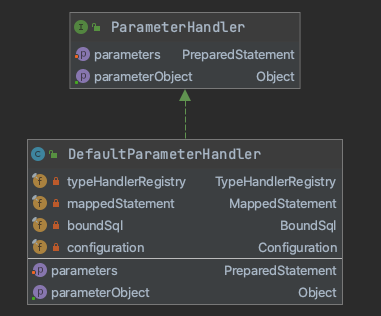一 参数处理器说明 参数处理器的接口定义在org.apache.ibatis.executor.parameter包下,但是他的默认实现在SQL解析相关的包org.apache.ibatis.scripting下。
UML图也很简单,只有一个接口和一个实现如下:
二 参数处理器源码解读 参数处理器接口ParameterHandler很简单仅定义了两个方法如下:
1 2 3 4 5 6 7 8 9 10 11 12 13 14 15 16 17 18 19 20 21 22 23 24 package org.apache.ibatis.executor.parameter;import java.sql.PreparedStatement;import java.sql.SQLException;public interface ParameterHandler Object getParameterObject () ; void setParameters (PreparedStatement ps) throws SQLException
DefaultParameterHandler参数处理器的实现源码解读如下
1 2 3 4 5 6 7 8 9 10 11 12 13 14 15 16 17 18 19 20 21 22 23 24 25 26 27 28 29 30 31 32 33 34 35 36 37 38 39 40 41 42 43 44 45 46 47 48 49 50 51 52 53 54 55 56 57 58 59 60 61 62 63 64 65 66 67 68 69 70 71 72 73 74 75 public class DefaultParameterHandler implements ParameterHandler private final TypeHandlerRegistry typeHandlerRegistry; private final MappedStatement mappedStatement; private final Object parameterObject; private final BoundSql boundSql; private final Configuration configuration; public DefaultParameterHandler (MappedStatement mappedStatement, Object parameterObject, BoundSql boundSql) this .mappedStatement = mappedStatement; this .configuration = mappedStatement.getConfiguration(); this .typeHandlerRegistry = mappedStatement.getConfiguration().getTypeHandlerRegistry(); this .parameterObject = parameterObject; this .boundSql = boundSql; } @Override public Object getParameterObject () return parameterObject; } @Override public void setParameters (PreparedStatement ps) ErrorContext.instance().activity("setting parameters" ).object(mappedStatement.getParameterMap().getId()); List<ParameterMapping> parameterMappings = boundSql.getParameterMappings(); if (parameterMappings != null ) { for (int i = 0 ; i < parameterMappings.size(); i++) { ParameterMapping parameterMapping = parameterMappings.get(i); if (parameterMapping.getMode() != ParameterMode.OUT) { Object value; String propertyName = parameterMapping.getProperty(); if (boundSql.hasAdditionalParameter(propertyName)) { value = boundSql.getAdditionalParameter(propertyName); } else if (parameterObject == null ) { value = null ; } else if (typeHandlerRegistry.hasTypeHandler(parameterObject.getClass())) { value = parameterObject; } else { MetaObject metaObject = configuration.newMetaObject(parameterObject); value = metaObject.getValue(propertyName); } TypeHandler typeHandler = parameterMapping.getTypeHandler(); JdbcType jdbcType = parameterMapping.getJdbcType(); if (value == null && jdbcType == null ) { jdbcType = configuration.getJdbcTypeForNull(); } try { typeHandler.setParameter(ps, i + 1 , value, jdbcType); } catch (TypeException | SQLException e) { throw new TypeException("Could not set parameters for mapping: " + parameterMapping + ". Cause: " + e, e); } } } } } }

